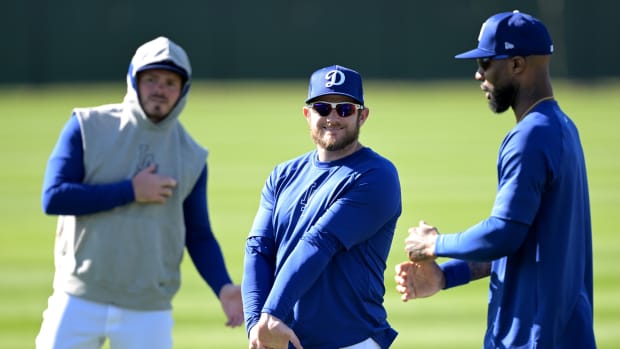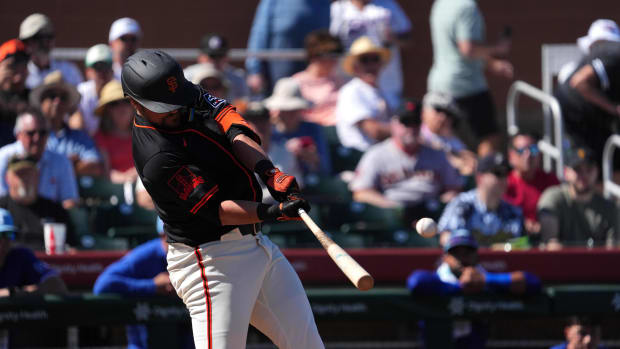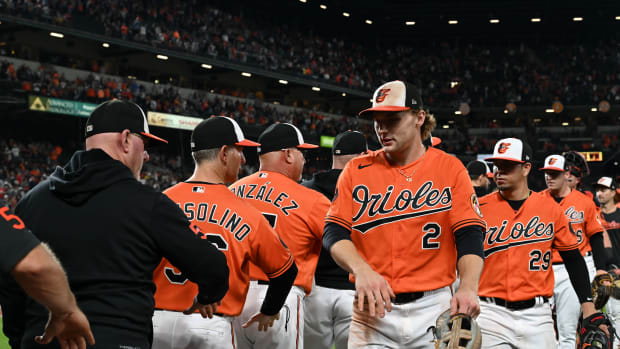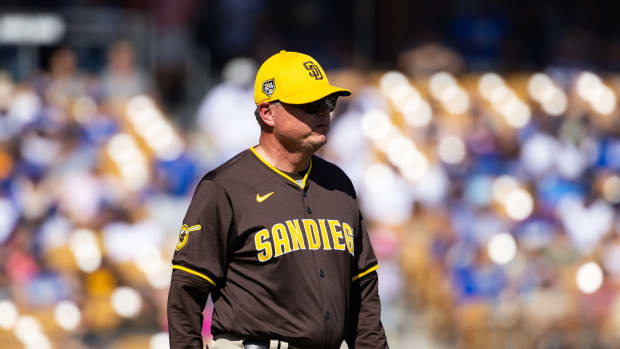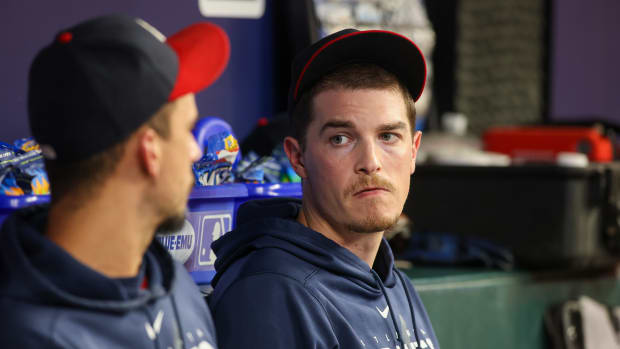Inside the Angels' Shohei Ohtani Deal and Giancarlo Stanton's Trade to the Yankees
Former MLB commissioner Fay Vincent liked to say that focusing on the business of baseball is like staring at the sun: One cannot do it for long. Today, however, in a $10 billion industry and a disruptive media environment, the corporate side is openly embraced. Last August, Cubs president of business operations Crane Kenney described the century-old bat-and-ball Chicago franchise this way: “We are a content company.”
Every year only one team can win the World Series, but all 30 must vie for attention and relevance. There are 162 games, but “content” includes all the buzz, narratives and brand-building in between them, too. These twin tracks of trying to win the last game of the year and win attention along the way were never more obvious than in a whirlwind 24 hours last weekend, when the two most dynamic available players in the world switched teams—and maybe changed the fortunes of the content companies that acquired them.
Midday on Friday free agent Shohei Ohtani, 23, often called the Babe Ruth of Japan because of his rare two-way prowess, announced he was signing with the Angels. As dawn broke the next day, so did the news that the Yankees had agreed on a trade with the Marlins to acquire National League MVP Giancarlo Stanton, 28, who joined Ruth and Roger Maris as the only players not connected to steroids to hit 59 home runs in a season. The Angels and Yankees immediately became not only better, but also enhanced by the biggest global star power available.
Ohtani’s unique skill set immediately energized a vanilla Anaheim franchise that hasn’t won a playoff game in eight years, ranked third-worst in local TV ratings (behind only the Athletics and White Sox) for a second straight year, has a fallow farm system and is perhaps most known for squandering the best years of the best player in the game, centerfielder Mike Trout.
“There was a wow factor to him,” said Angels general manager Billy Eppler of Ohtani, whom he had been scouting for four years. “He was a show-stopper.”
A 6' 6", 245-pound corner outfielder, Stanton joins homegrown sluggers Aaron Judge, Gary Sanchez and Greg Bird in a modern-day Murderers’ Row and returns the Bronx Bombers to their customary status as the most compelling team in baseball. Based mostly on the emergence of Judge, the 6' 7", 282-pound rightfielder who sold more jerseys than any other player in 2017 and received more All-Star votes than any other American Leaguer, ratings for games on the YES network last season soared 57% to their highest level in five years. So enthralling was Judge that a network source says YES could measure the increase in viewership whenever he came to the plate, as well as the decline after he had hit.
Giancarlo Stanton Trade Proves Derek Jeter Might Be Out of His Depth Running the Marlins
In Stanton and Judge, New York boasts the only two players to hit 50 home runs last season, the only two players 6’ 6” or taller who qualified for the batting title (never has there been a pair of qualified teammates so towering) and the two players who smashed the two hardest-hit balls of 2017 (122.2 and 121.1 mph).
Judge responded to the news by tweeting a clip of the actor Will Ferrell in Step Brothers: “Did we just become best friends?”
The sweetener for both clubs is that neither bore a burdensome cost for acquiring such rare marquee talent. Los Angeles won baseball’s version of the lottery when Ohtani chose them. Imagine someone who throws as hard as Noah Syndergaard and hits like Carlos Correa and does so while playing for minimum salary, and you begin to understand the “wow factor” of Ohtani.
The Angels will fork over a $20 million posting fee to his former team, the Hokkaido Nippon Ham Fighters, and a $2.3 million bonus for Ohtani. For that $22.3 million up front they get six years of Ohtani’s major league service, the first of which will pay him the major league minimum of $545,000—or less than what Stanton makes in four days.
In what amounted to a salary dump by the Marlins under their new COO, onetime New York great Derek Jeter, Miami received second baseman Starlin Castro and two low-level prospects (pitcher Jorge Guzman, 21, and shortstop Jose Devers, 18). The Marlins also gave $30 million to the Yanks, which leaves them on the hook for $265 million of Stanton’s contract over the next 10 years. The offset of Castro’s salary means that Stanton is a $13.4 million net addition to the 2018 payroll for luxury tax purposes—well below the $27.5 million average annual value that just came off the books for Alex Rodriguez. The net cost keeps principal owner Hal Steinbrenner’s ’18 goal possible: that the Yankees stay under the $197 million threshold to earn a one-time reset to their tax rate, providing enormous savings.
“Brian Cashman has done an excellent job,” says one NL executive. “He’s rebuilt the farm system with good players and he’s learned to stay away from the really bad, long contracts, other than the one to Jacoby Ellsbury. The Yankees are back. It’s good for baseball.”
The Bronx Bombers wanted Ohtani, too, but he eliminated them early in the most rare of free agent sweepstakes: Money didn’t matter. Ohtani’s bonus was capped at roughly $3 million because of a new rule limiting earnings of international free agents younger than 25. Had Ohtani waited two years he could have commanded perhaps $200 million, but proving himself now as both a major league hitter and starter mattered to him more.
Not since Ruth in 1919 and then Johnny Cooney in 1924 has a player started at least 15 games on the mound and at another position in the same season. Even the Bambino found such duality taxing, saying in 1918, “I don’t think a man can pitch in his regular turn and play every other game at some other position and keep that pace year after year.” He abandoned pitching in 1920, except for four random starts.
“I’m honored to be compared to Ruth,” Ohtani said at his news conference in Anaheim on Saturday, “but in no way do I think I’m at his level.”
Ohtani, a righthanded pitcher, went 42–15 with a 2.52 ERA in 85 games in Japan, fanning 624 in 543 innings, though only five of those games took place this year due to a right ankle injury. A lefty-hitting outfielder, he batted .286 in 403 games with an .859 OPS—numbers that resemble the major league career of Correa, the Astros’ All-Star shortstop.
Twenty-seven teams entered the Ohtani sweepstakes, after which his agent, Nez Balelo, told each organization to craft a point-by-point manifesto on what it had to offer Ohtani in facilities and support.
Meanwhile, MLB circulated Ohtani’s medical history. Sources from two of the teams say the report included a notation that Ohtani underwent a platelet-rich plasma injection on his right elbow in October. PRP has become popular as a conservative, nonsurgical treatment to address a wide variety of elbow issues. In some cases, such as with Zack Greinke in 2013 and Chris Sale in ’14, it treats inflammation and irritation. (Both pitchers missed only a few starts.) In other cases, such as strains or tears to the flexor tendon or ulnar collateral ligament, it is used instead of surgery. Yankees starter Masahiro Tanaka, for instance, underwent PRP therapy in 2014 to treat a small UCL tear and has pitched effectively since then. Other pitchers who tried PRP eventually needed Tommy John surgery, including Clay Buchholz and Drew Smyly this year.
Balelo explained to clubs that Ohtani underwent the PRP procedure as “a preventative measure,” telling them it is commonly used that way in Japan. To mitigate potential concerns, Balelo arranged for Ohtani to undergo a physical in California during the recruiting process and made the results available to interested clubs.
“It didn’t change the equation,” one team official says. “Worst-case scenario, if he loses two years, even if you wind up paying $60 million for four years, he’s still a bargain.”
Says one talent evaluator, “If he were in the draft he’d be the 1–1 pick. He’s a little like Yu Darvish—with a better fastball. He’s going to make an impact right away as a starting pitcher.”
Ohtani has thrown as hard as 102 mph. Like Tanaka, Hisashi Iwakuma and Hideo Nomo, who each excelled in as a rookie in the majors, Ohtani also uses a split-finger fastball, a pitch popular in Japan but rare in the big leagues. Hitters saw splitters only 1.5% of the time in 2017, batting just .217 against them.
“Lack of familiarity, arm slot, the pitch, are all to his advantage,” says one veteran manager. “But the quality of the pitch is more important than the uniqueness of it.”
Imagining Giancarlo Stanton in Middle of Yankees' Lineup
Soon after teams submitted their glorified essays, Ohtani cut the field to seven, eliminating every team in the Eastern time zone. Five of his finalists were losing clubs that finished a combined 140 games out of first place in their respective divisions: the Angels, Mariners, Rangers, Giants and Padres. All but San Diego have farm systems ranked among the bottom third, per Baseball America. The Cubs and Dodgers also made the final cut. The seven contenders were invited to make a two-hour pitch to Ohtani in L.A. early last week.
The Angels took their turn that Monday. On Thursday evening Ohtani visited Angel Stadium. The next morning, Balelo called teams and told them a decision had been reached. Around midday they would either get a phone call informing them that Ohtani would play for them, or they would read about where he had signed when Balelo released a statement. Los Angeles received the call at 11 a.m. In the statement, the agent explained, “what mattered to [Ohtani] most wasn’t market size, time zone or league but that he felt a true bond with the Angels.” Ohtani gave no specifics about his reasons, other than to say, “I just felt a strong connection” with the team.
Says one NL executive, “I think in the end it was about geography and the DH.”
Ohtani hasn’t played the outfield with any regularity since his rookie season in 2013. Most people viewed NL teams, without benefit of the DH, as disadvantaged in the sweepstakes. Indeed, L.A. immediately said that Ohtani won’t need his glove much next season. He could get about 400 plate appearances by DHing three times per week, sharing the role with Albert Pujols, who will need to get more work at first base after starting there just 34 times the past two years.
“I think he’s a legit hitter,” says a rival executive of Ohtani. “He’s extremely driven and motivated—kind of single-minded. He wants to be great. He wants to do something unique and he’s not afraid to step out and try something that has not been tried. From a makeup side, he’ll figure out whatever his flaws are and work them out. Right away, he’s going to be an impact starting pitcher.”
Says Giants general manager Bobby Evans, “He was impressive and thoughtful and humble and showed a good sense of humor. He’s going to be successful. He’s a good athlete, strong, determined and laser-focused. I think he’ll be as successful as any first-year player from Japan.”
Another executive points out that Ohtani faces a more difficult grind in the majors than he did in Japan. “There’s more stress on the arm here,” he says. “The ball in Japan is tackier and the mounds are softer. And in Japan guys don’t really pitch inside. Here they throw harder and are not afraid to hit somebody.”
By batting lefthanded, Ohtani exposes his pitching arm to the pitcher. In Japan he came to the plate 1,170 and was hit only four times.
The Angels control Ohtani, Trout, Pujols, shortstop Andrelton Simmons, and outfielders Justin Upton and Kole Calhoun for the next three seasons, after which Trout is eligible for free agency.
“I would expect they make a run at extending Trout, with the good feelings right now,” said one executive.
Meanwhile, in New York, Stanton will join a team that came within one game of the World Series, and is better equipped than any other to take advantage of the livelier baseball. With singles harder than ever to get because of defensive shifts and strikeouts harder than ever to avoid, the home run has become baseball’s Bitcoin—a currency that is surging in value as quick strikes replace rallies. Last season the top eight highest-slugging all made the playoffs, with the top-ranked Astros winning the World Series.
With Giancarlo Stanton, Yankees Build MLB's Most Fearsome Lineup. But at What Cost?
Without Stanton, the Yankees ranked fourth in slugging and first in home runs. So strong is Stanton that last year when he hit a fly ball, it was more likely to be a home run (43 times) than it was to be an out (35). He gives New York a historically powerful trio of young sluggers. Judge (56 homers after 182 games), Stanton (267 after 986) and Sanchez (53 after 177) rank second, third and fourth all time, respectively, in home runs at this juncture of their careers. Stanton is 16 ahead of Ruth’s pace through the same number of games.
Talk about power: The additions of Ohtani and Stanton reverberated in Las Vegas, where the Westgate Superbook immediately lowered the odds of the Yankees winning the World Series from 8–1 to 6–1, and the Angels from 50–1 to 30–1. Whether they earn the last victory of 2018 or not, both teams rose to the level of fascination—Los Angeles because of the mystery of Ohtani, and New York because of the menace presented by Stanton alongside Judge.
Never will the fascination be greater than on April 27, 28 and 29, when Stanton and the Yankees visit Anaheim to play Ohtani and the Angels. Should Ohtani start one of those games, the Babe Ruth of Japan will face the heir to Babe Ruth in pinstripes for the first time. Regular-season content doesn’t get any more appealing than that.































